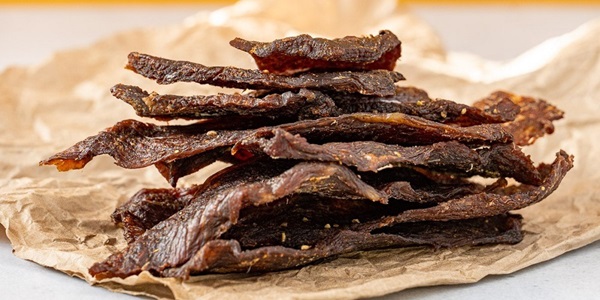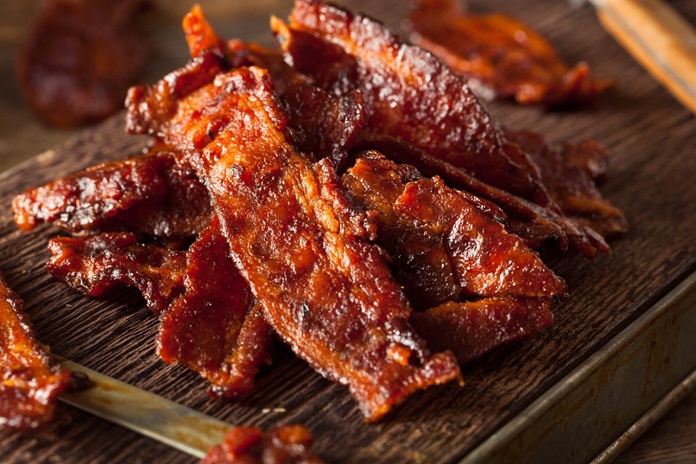National Craft Jerky Day is celebrated on November 27 every year. This is celebrated to honor homemade jerky and traditional jerky recipes handed down through generations. Jerky is any kind of dried, thinly sliced meat that you can eat as is. It can be made from many different kinds of meat, including beef, horse, alligator, camel, or crocodile. Craft Jerky Day encourages creativity with jerky, and its history goes back to the early 1550s.
History of National Craft Jerky Day
National Craft Jerky Day was created by the ‘Long Beach Jerky Co.’ The company was founded by Alex Naticchioni and Richie Beckman in 2013, but its legacy can be traced far beyond that.
It all began with Albert Naticchioni, fondly called ‘Gramps,’ Alex’s grandfather. Albert made his own jerky and stuffed it into the stockings of family members during Christmas.
National Craft Jerky Day was introduced by Long Beach Jerky Co., founded by Alex Naticchioni and Richie Beckman in 2013.
However, the tradition of making jerky goes back further to Alex’s grandfather, Albert Naticchioni, known as “Gramps.” He made homemade jerky and gave it to family members in their Christmas stockings.
The holiday tradition evolved into a business idea a year later when Alex and Richie came up with the concept while brainstorming in their Long Bead apartment. They decided to use Gramps’ original jerky recipe and also try out new ones.
After numerous experiments, Long Beach Jerky Co. was launched. Today, their menu features flavors like ‘Gramps’ Original,’ ‘Buffalo Wing,’ ‘Cracked Black Pepper,’ and ‘Spicy Teriyaki.’

According to historians, jerky originated in the Andes Mountains in what is now Peru. Jerky is a meat that is made by slicing lean meat into strips and drying it. The term ‘jerky’ comes from the Quechua word ‘ch’arki,’ which means date back to the 1550s.
Jerky is typically made by salting thin meat slices and drying them in the sun over a fire, or in an electric dehydrator. Once fully dried, jerky can be eaten without cooking.
The salting helps prevent bacterial growth, and if done correctly, jerky can be stored for months without spoiling. Modern jerky often includes preservatives, fat, and sometimes brown sugar to enhance flavor.
| 1550s (Ch’arki) | Evidence exists of the earliest records of ch’arki. |
| 1800s (Jerky) | Jerky has become a common protein source in pioneer America. |
| 2013 (Long Beach Jerky) | Long Beach Jerky Co. is founded by Alex Naticchioni and Richie Beckman. |
| 2016 (The Proclamation) | Craft Jerky Day is proclaimed a national holiday |
5 Important Facts About The Weirdest Jerky Flavors
Jerky has come a long way from its traditional flavors, and some of the most unusual varieties have caught the attention of adventurous eaters. Here are five important facts about the weirdest jerky flavors:
Innovative Ingredients: Some jerky makers experiment with unconventional ingredients to create unique flavors. For example, you might find jerky made with exotic meats like alligator, kangaroo, or even insects. These flavors often aim to provide a novel tasting experience and highlight the versatility of jerky.
Extreme Spice Levels: Jerky flavors can reach extreme levels of spiciness, incorporating ingredients like ghost peppers or Carolina Reapers. These super-hot varieties challenge the limits of heat tolerance and often come with warning labels for those brave enough to try them.
Unusual Sweet and Savory Combos: The blend of sweet and savory flavors in jerky can be surprising. Some varieties feature unusual pairings, such as maple bacon or apple pie. These combinations appeal to those looking for a unique taste experience beyond traditional salty or smoky profiles.
Cultural Fusion: Global influences have led to jerky flavors inspired by various cuisines. For instance, you might find jerky seasoned with Korean BBQ spices, Indian curry, or even Moroccan harissa. This fusion of flavors showcases how jerky can incorporate diverse culinary traditions.
Health-Conscious Options: With increasing interest in health and wellness, some jerky makers are crafting unusual flavors with health benefits in mind. For example, jerky infused with turmeric or spirulina aims to offer not only a unique taste but also potential nutritional benefits. These options cater to health-conscious consumers looking for a snack that aligns with their dietary goals.
Conclusion
National Craft Jerky Day on November 27 celebrates the tradition of homemade jerky and its evolution from ancient practices to modern innovations. Originating in the Andes and popularized by Long Beach Jerky Co., this day honors both traditional recipes and creative new flavors. Whether enjoying classic or unusual varieties, it’s a perfect time to appreciate jerky’s rich history and diverse taste experiences.
Frequently Ask Question
When did National Craft Jerky Day start?
The day was introduced by Long Beach Jerky Co., founded in 2013 by Alex Naticchioni and Richie Beckman. The celebration became a recognized holiday in 2016.
What is the origin of jerky?
Jerky originated in the Andes Mountains in what is now Peru. The term “jerky” comes from the Quechua word “ch’arki,” which refers to dried meat.
How is jerky traditionally made?
Jerky is made by slicing lean meat into strips, salting them, and drying them either in the sun, over a fire, or in a dehydrator. This process helps preserve the meat and prevent spoilage.
What are some unusual jerky flavors?
Some unique jerky flavors include exotic meats like alligator or kangaroo, extremely spicy options with ghost peppers, sweet and savory combinations like maple bacon, and culturally inspired flavors such as Korean BBQ or Moroccan harissa.
You may also like to read, National Fried Rice Day – September 20, 2024
